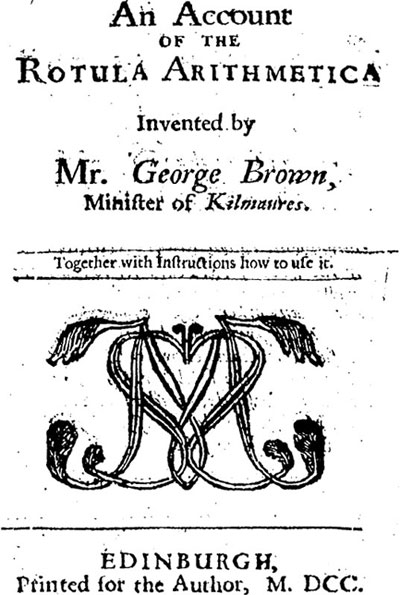The Scottish inventor and arithmetician, George Brown, had an affinity for all things numbers. He lived during the 1600-1700s and made significant contributions to the field of mathematics. Brown created two mechanical calculating devices (although incomplete), as well as a new and simpler method for teaching arithmetic. His calculating device, the Rotula Arithmetica, could perform simple addition, subtraction, multiplication, and division. Brown’s teaching method can be found in his book Rotula Arithmetica, published in 1700. Brown was also a minister, although he was not very good at it. He frequently got in trouble for his lack of enthusiasm when it came to prayers and for not adhering to procedures.
George Brown’s Rotula Arithmetica
George Brown (1650-1730) was a Scottish arithmetician and minister, known for the invention of an arithmetical instrument, called Rotula Arithmetica—a device for simple addition, subtraction, multiplication, and division.
Brown attended Aberdeen’s Kings College, matriculating in 1664 and graduating in 1668. Then he worked as a teacher of mathematics in Edinburgh. Later on, he worked as a minister in Stranraer, schoolmaster in Fordyce, and from 1680 schoolmaster at Kilmaures. In the 1690s, Brown invented Rotula Arithmetica and in 1698 he was given the sole privilege (something like a patent) to frame, make and sell his instrument for the space of 14 years…
Brown described his instrument in the book, An Account of the Rotula Arithmetica (see a copy of the book), published in 1700 in Edinburgh (see below the title page of the book). In the same year 1700, he published another book, called A Specie Book, to be used in conjunction with the Rotula Arithmetica. The book contains currency tables because many of the coins were not Scots-minted silver, but foreign currency, legal tender in Scotland, at values fixed by the Privy Council and Parliament.

Several copies of the instrument were made, but it is doubtful that Brown himself made the rotula. He probably employed an engraver. The instrument in the lower photo is inscribed for the right Honble Patrick Earle of Marchmont, Lord High Chancelour of Scotland, Feb 28. 1699, as Brown was clearly searching for an influential patron (Sir Patrick Hume (1641-1724) was a Scottish statesman).

The Rotula consists of two parts: a circular plain (movable plate), moving upon a center-pin; and a ring (fixed plate), whose circles are described from the same center. The outermost circular band of the moveable, and the innermost of the fixed, are divided into a hundred equal parts, and these parts are numbered 0, 1, 2, 3. etc. Upon the ring, there is a small circle having its circumference divided into ten equal parts, furnished with a needle that shifts one part at every revolution of the moveable. With this simple instrument, the calculations can be done by moving the plate around the axes and accounting for the numbers, as the four arithmetical operations can be performed not only for integers but also for decimals finite and infinite.
George Brown was a good mathematician, but a poor minister. He wasn’t zealous in prayers and was frequently charged for exercising discipline and marrying without proclamation. He was banished from Edinburgh from 1692 until 1698, for “… he had not prayed for their said majesties and in the terms aforesaid and having refused to do the same in time coming…”.
Brown was the author of several other mathematical books, which popularized decimal notation. The last of them, Arithmetica Infinita, was endorsed by famous Scottish mathematician John Keill.
George Brown died in 1730 in London.
The image featured at the top of this post is ©G-Stock Studio/Shutterstock.com.







